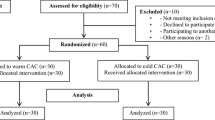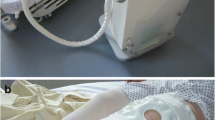Abstract
Introduction
The use of evaporative coolants in the management of acute musculoskeletal injury has received increasing attention recently. However, its efficacy compared with conventional cryotherapy in treating injured human subjects remains unclear. The purpose of this study is to compare the efficacy of evaporative coolants with that of ice packs in preoperative management of edema and pain in patients with an ankle fracture.
Material and methods
Sixty-three patients in need of surgical treatment for ankle fracture were randomly assigned to either an evaporative coolant group or an ice pack group. Both treatments were applied for 5 days after injury and outcomes were measured daily. The primary outcome was a reduction in edema as measured by the figure-of-eight-20 method and the secondary outcome was measured by visual analog scale (VAS) for pain.
Results
Two-way analysis of variance with repeated measures showed no significant group effect and no significant group-by-time interaction in terms of reduction of edema and VAS score for pain between two groups. No adverse effects were reported in either group.
Conclusion
Evaporative coolants exhibited comparable efficacy to ice packs in preoperative cryotherapy of ankle fractures without adverse effects. While evaporative coolants are more expensive than ice packs, they can present a viable option for cryotherapy.
Level of evidence
Level I, prospective randomized study.




Similar content being viewed by others
References
Airaksinen OV, Kyrklund N, Latvala K, Kouri JP, Gronblad M, Kolari P (2003) Efficacy of cold gel for soft tissue injuries: a prospective randomized double-blinded trial. Am J Sports Med 31:680–684
Bleakley C, McDonough S, MacAuley D (2004) The use of ice in the treatment of acute soft-tissue injury: a systematic review of randomized controlled trials. Am J Sports Med 32:251–261
Bleakley CM, McDonough SM, MacAuley DC, Bjordal J (2006) Cryotherapy for acute ankle sprains: a randomised controlled study of two different icing protocols. Br J Sports Med 40:700–705 (discussion 705)
Wright JG, Araki CT, Belkin M, Hobson RW 2nd (1989) Postischemic hypothermia diminishes skeletal muscle reperfusion edema. J Surg Res 47:389–396
McMaster WC, Liddle S (1980) Cryotherapy influence on posttraumatic limb edema. Clin Orthop Relat Res 150:283–287
Meeusen R, Lievens P (1986) The use of cryotherapy in sports injuries. Sports Med 3:398–414
Best TM (1997) Soft-tissue injuries and muscle tears. Clin Sports Med 16:419–434
Swenson C, Sward L, Karlsson J (1996) Cryotherapy in sports medicine. Scand J Med Sci Sports 6:193–200
VanGelder CM, Sheridan RL (1999) Freezing soft tissue injury from propane gas. J Trauma 46:355–356
Drez D, Faust DC, Evans JP (1981) Cryotherapy and nerve palsy. Am J Sports Med 9:256–257
Rohner-Spengler M, Mannion AF, Babst R (2007) Reliability and minimal detectable change for the figure-of-eight-20 method of, measurement of ankle edema. J Orthop Sports Phys Ther 37:199–205
Carlsson AM (1983) Assessment of chronic pain. I. Aspects of the reliability and validity of the visual analogue scale. Pain 16:87–101
Katz J, Melzack R (1999) Measurement of pain. Surg Clin North Am 79:231–252
Mumith A, Pavlou P, Barrett M, Thurston B, Garrett S (2015) Enhancing postoperative rehabilitation following knee arthroplasty using a new cryotherapy product: a prospective study. Geriatr Orthop Surg Rehabil 6:316–321
Duan F, Ward CA (2005) Surface excess properties from energy transport measurements during water evaporation. Phys Rev E Stat Nonlin Soft Matter Phys 72:056302
Lachenmeier DW (2008) Safety evaluation of topical applications of ethanol on the skin and inside the oral cavity. J Occup Med Toxicol 3:26
O'Hare K, Spedding P, Grimshaw J (1993) Evaporation of the ethanol and water components comprising a binary liquid mixture. Dev Chem Eng Miner Process 1:118–128
Hopkins RJ, Reid JP (2005) Evaporation of ethanol/water droplets: examining the temporal evolution of droplet size, composition and temperature. J Phys Chem A 109:7923–7931
Bongers CC, Hopman MT, Eijsvogels TM (2017) Cooling interventions for athletes: An overview of effectiveness, physiological mechanisms, and practical considerations. Temperature (Austin) 4:60–78
Weiner JS, Khogali M (1980) A physiological body-cooling unit for treatment of heat stroke. Lancet 1:507–509
Hadad E, Moran DS, Epstein Y (2004) Cooling heat stroke patients by available field measures. Intensiv Care Med 30:338
Rohner-Spengler M, Frotzler A, Honigmann P, Babst R (2014) Effective treatment of posttraumatic and postoperative edema in patients with ankle and hindfoot fractures: a randomized controlled trial comparing multilayer compression therapy and intermittent impulse compression with the standard treatment with ice. J Bone Jt Surg Am 96:1263–1271
Funding
There is no funding source.
Author information
Authors and Affiliations
Contributions
YHP: lead investigator and first author, writing manuscript. JHS: performing study intervention and data analysis. TJK: outcome assessment and manuscript review. SHK: outcome assessment and data analysis. ASC: outcome assessment and data analysis. HJK: corresponding author and study coordinator, manuscript review.
Corresponding author
Ethics declarations
Conflict of interest
The authors declare that they have no conflict of interest. No benefits in any form have been received or will be received from a commercial party related directly or indirectly to the contents of this study.
Ethical approval
This study was approved by the institutional review board of the authors' institutions. All procedures performed involving human participants were in accordance with the ethical standards of the institutional and/or national research committee and with the 1964 Helsinki Declaration and its later amendments or comparable ethical standards.
Additional information
Publisher's Note
Springer Nature remains neutral with regard to jurisdictional claims in published maps and institutional affiliations.
Rights and permissions
About this article
Cite this article
Park, Y.H., Song, J.H., Kim, T.J. et al. Comparison of the use of evaporative coolants and ice packs for the management of preoperative edema and pain in ankle fractures: a prospective randomized controlled trial. Arch Orthop Trauma Surg 139, 1399–1405 (2019). https://doi.org/10.1007/s00402-019-03222-7
Received:
Published:
Issue Date:
DOI: https://doi.org/10.1007/s00402-019-03222-7




